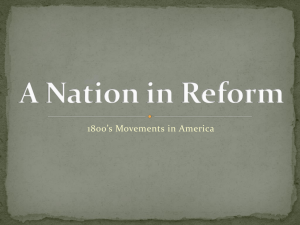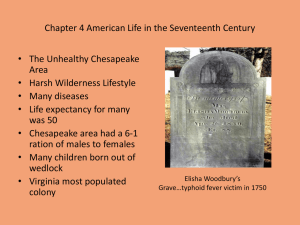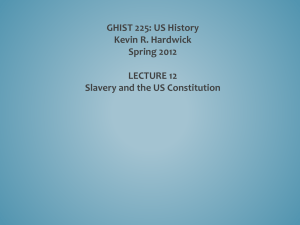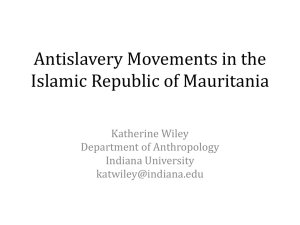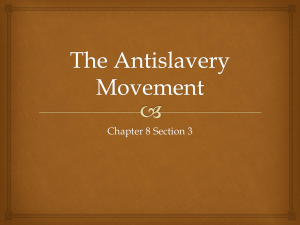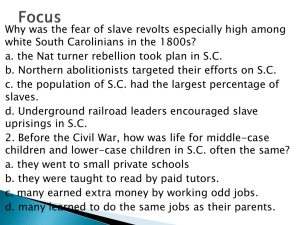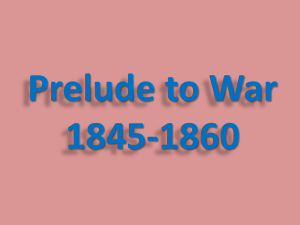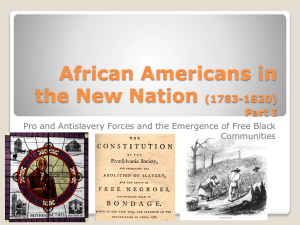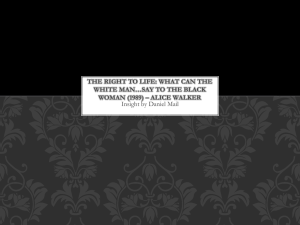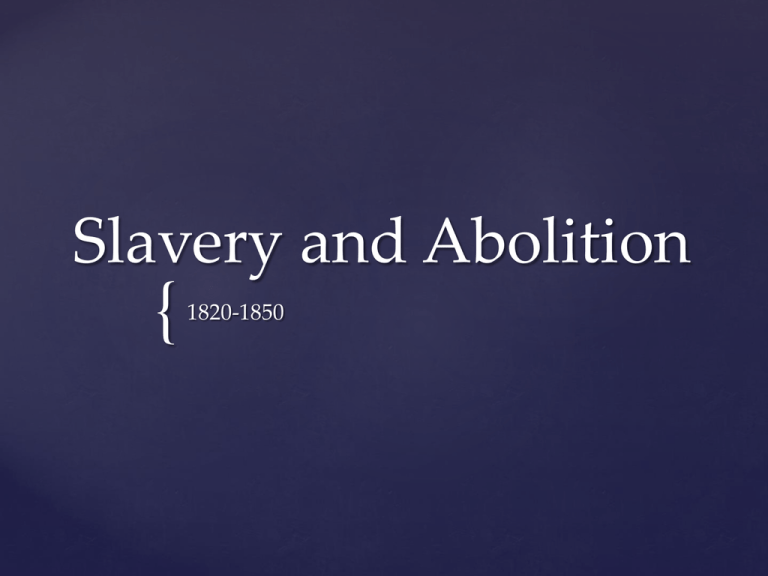
Slavery and Abolition
{
1820-1850
Prior to the 1820s the view of slavery was in conflict with
the ideas of the American Revolution, particularly the
statement by Thomas Jefferson in the Declaration of
Independence that “all men are created equal.” For this
reason, the attitude held by most slave owners was that
slavery was immoral, but since the economy in the south
was based on cash crop agriculture that used slave labor,
it also was an economic necessity!
By the 1820s, cotton production made the South so rich
that to justify owning slaves to themselves, Southerners
began to change their opinions about slavery. Now they
argued that slavery was a “positive good” and that
slavery actually helped slaves. They wanted to make
themselves feel better about slave owning.
Slavery in the South
Because the economy in
the South was based on
agriculture, his meant that
the south had little
industry of its own.
Because the south had
little industry, residents
had to buy most of their
manufactured goods from
the north or Europe. They
paid more money than
people in the north for
manufactured items. This
meant that the south got
little benefit from the high
protective tariff, and were
against the tariff.
Cotton was the main cash crop. While the
south is known for its Plantation system,
most people lived as subsistence
farmers. Only 25% of whites owned
slaves because slaves cost a lot of money.
Of those whites who owned slaves, most
only owned one or two.
Abolition
Reform movement by people who
wanted to end slavery in the
United States.
By the 1850s, 40% of the population of
the South were slaves. These slaves were
valuable because the growing southern
economy provided the world with 2/3 of
its cotton supply. Because cotton and the
slave labor system that supported it were
so valuable, any suggestion that the
south end slavery brought about
tremendous opposition.
Rise of the Abolition
Movement
1. Conservative: Emancipation of slaves and their return to Africa
with financial Compensation by the US government to slave owners.
“America Colonization Society:” organization who wanted to end
slavery by buying slaves from their masters & sending them to
live Liberia (Africa) because they believed Africans were inferior
to whites and should not live in the US.
2. Radical: Emancipation through slave revolt.
3. Moderate: Emancipation by appealing to the Christianity of
slave owners.
Strategies of Abolitionists
The moderate abolition movement was started in
the north in the 1830s by William Lloyd Garrison
who published “The Liberator” an anti-slavery
newspaper. He was helped by many abolitionist
leaders from New England who saw slavery as a
VIOLATION of Christian principles. They wanted
slaves to be emancipated (freed). He demanded
the” immediate and uncompensated emancipation
of slavery.”
Another important abolitionist was
writer Harriet Beecher Stowe, the wife of
a New England preacher. In 1852 she
wrote the best selling book Uncle Tom’s
Cabin that created widespread sympathy
for slaves and horror towards the slave
system. By 1860 it was the 2nd best
selling book in the world, passed only by
the Bible!
REBELLIONS: the most famous call for
rebellion was issued by a man named
David Walker. He was a free black who
lived in New York and worked for an
abolitionist newspaper. In 1830 he wrote
pamphlets calling for slave rebellions.
Unfortunately he died before the most
famous rebellions occurred
The most famous slave rebellion was
Nat Turner’s Rebellion in 1831. Nat
Turner was a house slave who hoped
to be set free by his master. Instead he
was sold, and was separated from his
family and was sent to work in the
Virginia fields. Turner became a
preacher and convinced himself he
was sent to Earth by God to lead a
race war. He interpreted a comet as an
omen to attack, and led 50 other blacks
in a rampage killing 200 white slave
owners and their families. After a few
days the rebels were hunted down by
a posse and were hanged. Turner hid
in the swamp for 2 months before he
was captured and hanged.
The Nat Turner Rebellion
Turner’s rebellion
was IMPORTANT
because:
1. it scared slave
owners
2. slaves were
banned from
learning to read
3. harsher slave
codes were passed
4. freed slaves had to
leave Virginia
within 6 months
Results of Turner’s Rebellion
Another way slaves opposed slavery was by
running away. Most who ran away did so to
reunite with family members in the North. The
most famous route north was called the
Underground Railroad-- the nickname for the
informal network of abolitionists willing to
help slaves escape. The hid these slaves in their
houses and provided food. The most famous
of these “conductor” on the Underground
Railroad was Harriet Tubman who made 50
successful trips.
The Underground Railroad
Several former slaves such as:
Sojourner Truth and Frederick Douglass tried to appeal to
the consciences of individual slave owners by arguing that:
1. slavery was morally wrong
2. black people were equal to whites
Southerners who defended slavery were called Apologists.
They argued that slavery was good because:
1. slavery forced Africans to become Christians
2. black people were inferior to whites both biologically
and intellectually
To maintain the country as one piece, in 1836 Congress
adopted the “Gag Rule.” The idea was that the
abolitionist issue would not bring other business in
Congress to a complete stop. This rule stayed in effect until
1848. HOWEVER as the United States expanded west,
conflict over slavery grew more heated and threatened to
tear the country apart.




